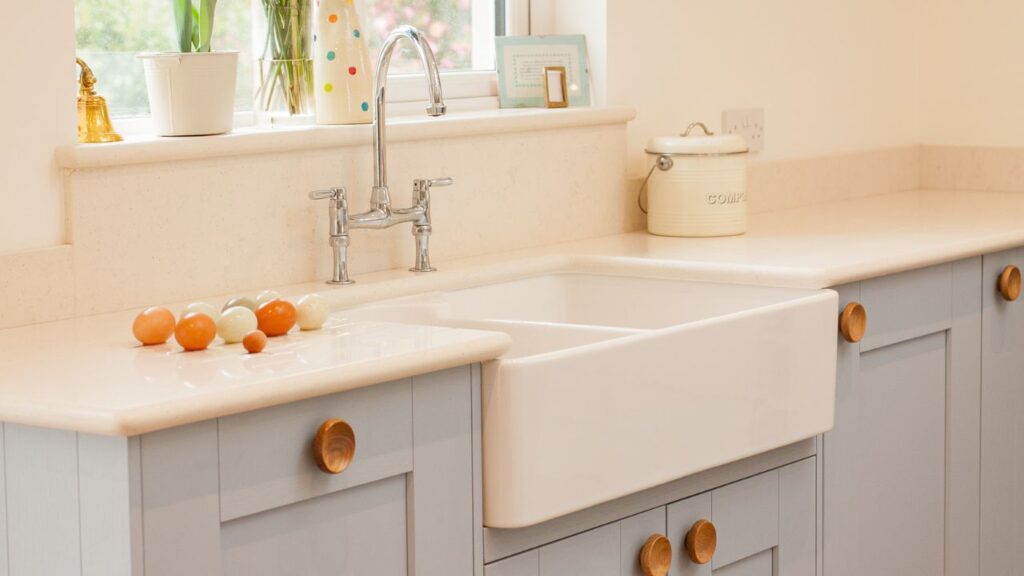Farmhouse sinks, known for their deep basins and charming, rustic appeal, have become a popular choice for homeowners seeking to add a touch of vintage style to their modern kitchens. However, installing these sinks can be a touch more intricate than with traditional kitchen sinks. But don’t worry! With the right guidance, you too can install a farmhouse sink in your kitchen and enjoy the blend of functionality and aesthetic charm it brings.
Choosing The Right Farmhouse Sink & Installation Type
Before we roll up our sleeves, let’s first pick the right sink and decide on the installation type. Farmhouse sinks can be installed in three distinct ways: flush mount where the sink is level with the countertop, built-up where the sink sits above the countertop, and undermount, where the sink sits just below the countertop. The installation type you choose will depend on the sink model, so always refer to your specific sink’s installation instructions. Some models are designed for top-mount or “”drop-in”” installation, while others can be fitted into existing cabinetry.
Essential Tools & Materials Needed
Before we get started, let’s gather our tools. You will need a drill, a jigsaw or multi-tool, a screwdriver, and a level. A measuring tape will be handy to ensure the perfect fit for your sink. You’ll also need 2×4 lumber for supports and plywood if necessary. Don’t forget the wood glue and sandpaper. For the plumbing work, you will need a plumber’s wrench, a bucket, and towels.
Now, here’s a word of caution – farmhouse sinks can be quite heavy. It’s a good idea to have a second pair of hands to help you safely lift the sink.
In the next part of this article, we will go into the details of taking out your existing sink and countertop, preparing the cabinet for your new farmhouse sink, and building the necessary support structures for the sink.
Remember, installing a farmhouse sink is more than just a home improvement project. It’s an opportunity to bring in a bit of rustic charm and make your kitchen a more inviting place. With the right tools, materials, and guidance, you’ll soon be enjoying the benefits of your new farmhouse sink. So, stay tuned for the following sections of this article where we continue our step-by-step guide to installing a farmhouse sink.
Preparing Your Kitchen: Removing The Existing Sink & Countertop
We’re now ready to prepare your kitchen for the new farmhouse sink. This will involve removing the existing sink and possibly the countertop, depending on your current setup.

First off, we need to ensure we’re working safely. Locate the water supply valves under your sink and turn them off. Disconnect the water supply lines and drain pipe. It’s a good idea to keep a bucket and some towels handy to catch any residual water that may spill out.
Now, we need to remove the existing sink. If it’s a top-mount sink, it’s likely held in place by clips under the countertop. You can use a screwdriver to loosen these clips. If you have an undermount sink, it’ll be bonded to the underside of the countertop using adhesive. In this case, you’ll need to cut through this adhesive with a utility knife.
Once the sink is free, lift it straight up and out of the countertop. If your countertop also needs to be removed, disconnect it from the cabinets and lift it off.
Modifying The Cabinet For A Farmhouse Sink
Next, let’s move on to modifying the cabinet for the farmhouse sink. You might need to make some adjustments to ensure the sink fits perfectly.
If your cabinet has a false front panel, it’s time to remove it. Don’t throw it away, though! You can repurpose it as a trim piece later on.
Now, using the template provided with your sink, mark the area on the cabinet that needs to be cut out. This should be done carefully using a jigsaw or an oscillating saw. It’s important to cut slowly and accurately to avoid damaging the cabinet.
Once the cutting is complete, smooth out the cut edges with some sandpaper. This will not only make the edges safer to handle, but it will also ensure a good fit for your sink.
Building Support Structures For The Sink
Moving on, it’s time to build support structures for your sink. Farmhouse sinks tend to be quite heavy, especially when full of water, so they need adequate support.
To do this, install ledges inside the cabinet using 2×4 lumber. The height of these supports will depend on the specific sink model you have, but they typically sit just below the top of the cabinet frame. Ensure that these supports are level on all sides.
Remember, the key to a successful installation is taking the time to measure and cut accurately. The more precise you are during these stages, the better your sink will fit, and the more stable it will be.
In the next part of this article, we’ll cover the steps of setting and leveling your new farmhouse sink, installing the drain and fixtures, and adding the finishing touches. Stay tuned for those next steps in your farmhouse sink installation journey.
Setting & Leveling The Farmhouse Sink
With the supports in place, we’re now ready for one of the most exciting parts of the process – setting the farmhouse sink into its new home! This step is crucial as it determines how well your sink fits and functions.
Place your sink onto the supports, ensuring it is centered in the cabinet and aligned with the countertop cutout. Remember, precision is key here. Take the time to measure and adjust as needed. Once the sink is in place, check that it’s flush with the cabinet and countertop. If it’s not, don’t panic! Some simple shims can help adjust the sink to the ideal level.
Use a level to make sure the sink is perfectly horizontal. Place it along the sides and front of the sink to check. If any adjustments are needed, use shims to prop up areas that are too low. Once the sink is level, we can move on to the next step.
Installing Drain & Fixtures
Now that your sink is in place and level, it’s time to hook up the plumbing. With the sink now accessible, you can install the basket strainer or disposal flange. Use plumber’s putty to ensure a water-tight seal.
Next, dry fit the drain plumbing. This allows you to see how everything fits together before final installation. Adjust as needed to ensure a good fit. Once everything is aligned, reconnect the water supply lines using the appropriate fittings.
Finalizing The Installation
If you’re installing an undermount farmhouse sink, the next step involves setting the countertop in place over the sink rim. Make sure the sink and countertop are flush. This not only ensures a professional look but also helps prevent water from seeping into any gaps.
Now onto the final touches! Attach the faucet and any additional trim or front panel as needed. The last thing to do is turn on the water and check for leaks. Fill up the sink and watch how it drains. Make sure everything is working as it should.
Conclusion
Installing a farmhouse sink is quite the project, but the end result is incredibly rewarding. The key to a successful installation is patience, precision, and a little bit of elbow grease. It’s about taking the time to measure, cut, and fit everything accurately. It’s also about knowing when to ask for help, especially with the heavy lifting.
As you’ve seen, installing a farmhouse sink involves several steps, but don’t let this intimidate you! With the right tools and some careful planning, you can transform your kitchen and enjoy the rustic charm of a farmhouse sink. So, roll up your sleeves and get started on your farmhouse sink installation journey!”





